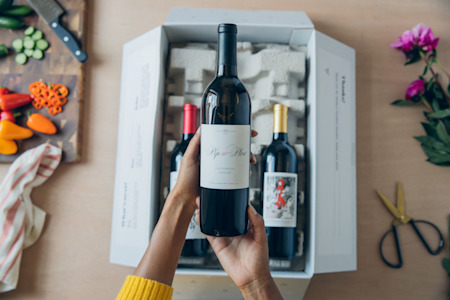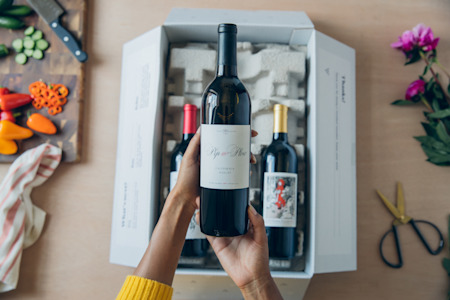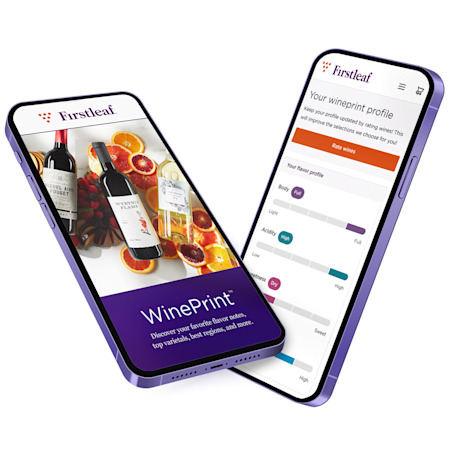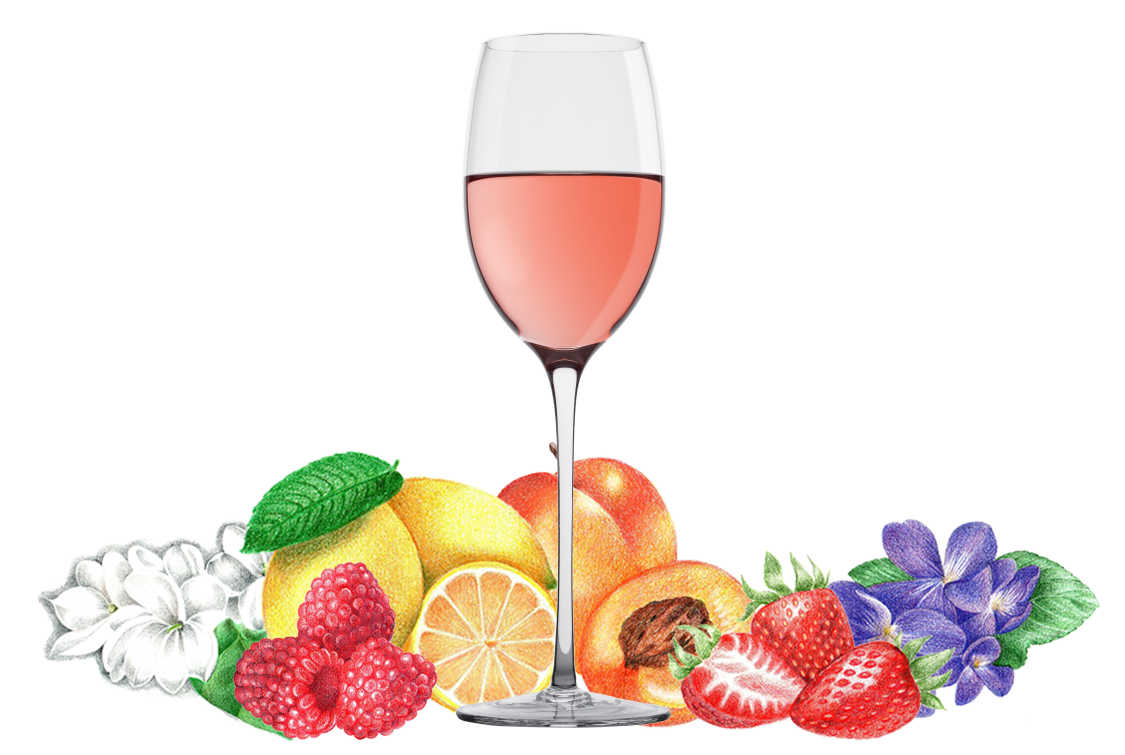Rosé
What is Rosé? Read below to find out more about these beautifully colored wines
Over the past decade, rosé wines have gone through an image overhaul. The chilled glasses of pink wine that were once relegated to summers in the south of France have come back into fashion and are here to stay. Rosé exists in the sweet spot between white and red wines, somewhere between the refreshing crispness of a Sauvignon Blanc and the bright red fruit notes of a Pinot Noir.
Depending on the types of grapes used and the method for producing a rosé, the resulting wines can range from pale peach to deep fuchsia, with a garden of tasting notes from rose petals to watermelon, to ripe raspberries and bright zest citrus.

Take Our Quiz Today
Get award-winning delicious wines from all over the world shipped straight to your door. Take the quiz to get the perfect pairings for your holiday season.
Take The Quiz TodayIN THIS ARTICLE:
History of Rosé
The first recorded rosés were blends of white and red grapes, pressed together to make a light-colored, low alcohol, easy drinking wine. In Ancient Greece and Rome, heavy reds were not in style, and they often preferred wines that had only a brief period of skin contact to impart taste and color.
Even after the fall of the empire, rosé continued to be produced. Bordeaux was famous for making Clariat, a rosé that eventually lent its name to the famous red wines, Claret.
Following the second World War, a new style emerged in Portugal. Lancers and Mateus were two Portuguese companies that pioneered a style of sweet pink wine that proved to please palates internationally and influenced the rise of California blush wines and White Zinfandel.
These sweet and overly fruity versions of the pink stuff didn’t do much for the reputation of the lovely Provençal rosés and those from Bandol, but a sea change in the early 2000s brought dry rosé back into its well deserved place in the sun.
Fun Fact
More than a few celebrities have gotten into the rosé game. Jon Bon Jovi, Drew Barrymore, John Legend and Brad Pitt and Angelina Jolie all have their own labels.
What does Rosé taste like?
To best understand the flavor profile of a specific rosé, judging a bottle by its color is a good place to start. Cotes de Provence rosés tend to be pale and almost peachy in color. Taste wise, they are dry, crisp with enough acidity to pair with the garlicky dishes that are native to this Mediterranean region. In contrast, the wines of Tavel in Cotes du Rhone region are deeper in color and fuller in body, with earthy notes that lean more towards a light red than a white wine.
How is Rosé Made?
The traditional method for making the best rosés allows the grape skins to have a short amount of contact with the fresh juice. Adjusting the maceration period gives the winemaker control of the hue and flavors of the rosé. Removing the skins after just a few hours creates a paler wine, and letting them sit for a few days imparts more color and structure.
Saignée, the French term for bleeding, is a style of winemaking in which red grape juice is removed from a tank in the early stages of fermentation in order to produce rosé.
Blending red and white wines is another method of making rosé. Employing this technique is generally frowned upon, but there are exceptions to almost every rule in the wine world. And this method has been has been used to make rosé Champagne for centuries. That lovely bottle of sparkling wine made primarily from Chardonnay gets its pink color and unique taste from the addition of Pinot Noir and Pinot Meunier grapes.
Fun Fact
Those curvy, classic bottles of rosé hailing from Provence owe their distinctive shape to father and son team, Marcel and René Ott of Domaine Ott who patented the elongated bowling pin silhouette look back in the 1930s.
Rosé Nutritional Facts
The nutritional value of Rosé varies greatly depending on two main factors: alcohol and sugar.
Some rosé is sweet, some rosé is dry, but generally the more sugar present in a wine, the more carbohydrates. The alcohol in rosé is generally low to moderate.
How to Serve and Store Rosé
There’s no need for pomp and circumstance when cracking open a bottle of rosé. The wine’s laid back nature doesn’t necessitate any fancy glassware or decanting, simply chill as you would a bottle of white, open and enjoy.
Most rosés are made (and bought) for immediate consumption, there are some bottles that can stand up to a few years of aging. Made from Mourvedre grapes originally hailing from Spain, wines from the Bandol have the tannins and structure to improve with a few years of aging when well stored.
What to Pair with Rosé
Pairing wine has some general rules, but we think the most important rule is to drink rosé with the food you like.
Rosé’s affinity for all things summery is a good place to start when thinking about pairing. Think of a dish that can be enjoyed at the beach, by the pool or at a barbecue, and chances are that it will play nicely with a bottle of rosé.
Because there are so many variations on the style, rosé can be paired with almost any meal. A seafood-centric feast welcomes a light bodied, high acidity bottle from Côtes de Provence, while bigger Loire Valley rosé can stand up to a spread of grilled ribs and potato salad.
Of course, when the weather turns cool, there’s no reason to shelve your favorite rosé. Dry rosés are always a welcome addition to the Thanksgiving, Christmas and Easter tables.
Rosé Wine Regions Around the World
The rise in rosé’s popularity has seen an influx of different styles from around the world, giving pink wine fans a chance to taste through an array of unique styles made everywhere from Coteaux d’Aix-en-Provence to the Veneto.
France:
The Cotes de Provence appellation is the biggest player in France’s rosé game. Blends of Grenache, Syrah, Cinsault and Mourvedre are used all over the south of France, making the majority of the region’s production not red or white wine, but pale pink rosé. The Mediterranean region might be the most well-known, but rosé is made all over France, even in regions like Champagne and Bordeaux that are known for other styles of winemaking.
Spain:
Spanish rosatos in Rioja are primarily made using Tempranillo, Merlot, Carbernet Sauvignon and Garnacha. One particularly intriguing rosado comes from Txakoli, a region in the Basque country that produces effervescent bottles of sparkling white and rosé wines.
Italy:
In Italian, there are serval terms for rosé, from rosato meaning pinkish to Cerasuolo translating to cherry red, and Ramato, or auburn wine. These styles each have their own preferred varietals. In Tuscany Sangiovese makes a beautiful rosato, Sicilian Cerasuolos feature Frappato grapes, and ramato is a rosé made with Pinot Grigio grapes.
United States:
After shaking off the stigma of the sweet blushes and White Zinfandels of years gone by, the U.S. has gotten into producing some fantastic rosé. On the east end of Long Island, producers have leaned into cool weather varietals like Cabernet Franc to make fresh pink wines and sparkling rosés for hot summer days. In Oregon, luck with red Pinot Noirs has translated into a thriving rosé scene that has been innovating with canned wines.

Take The Quiz
Learning about different wine varietals and regions is fun. Take the quiz now to explore wines matched to your unique palate.
Take The QuizIN THIS ARTICLE

WinePrint™ by Firstleaf
Are you looking to learn more about your wine preferences? Check out our Wine Print for an in-depth look at your personal tasting profile. Discover your favorite wines, varietals, regions, and tasting notes and get personalized recommendations wherever you are.
Learn More
